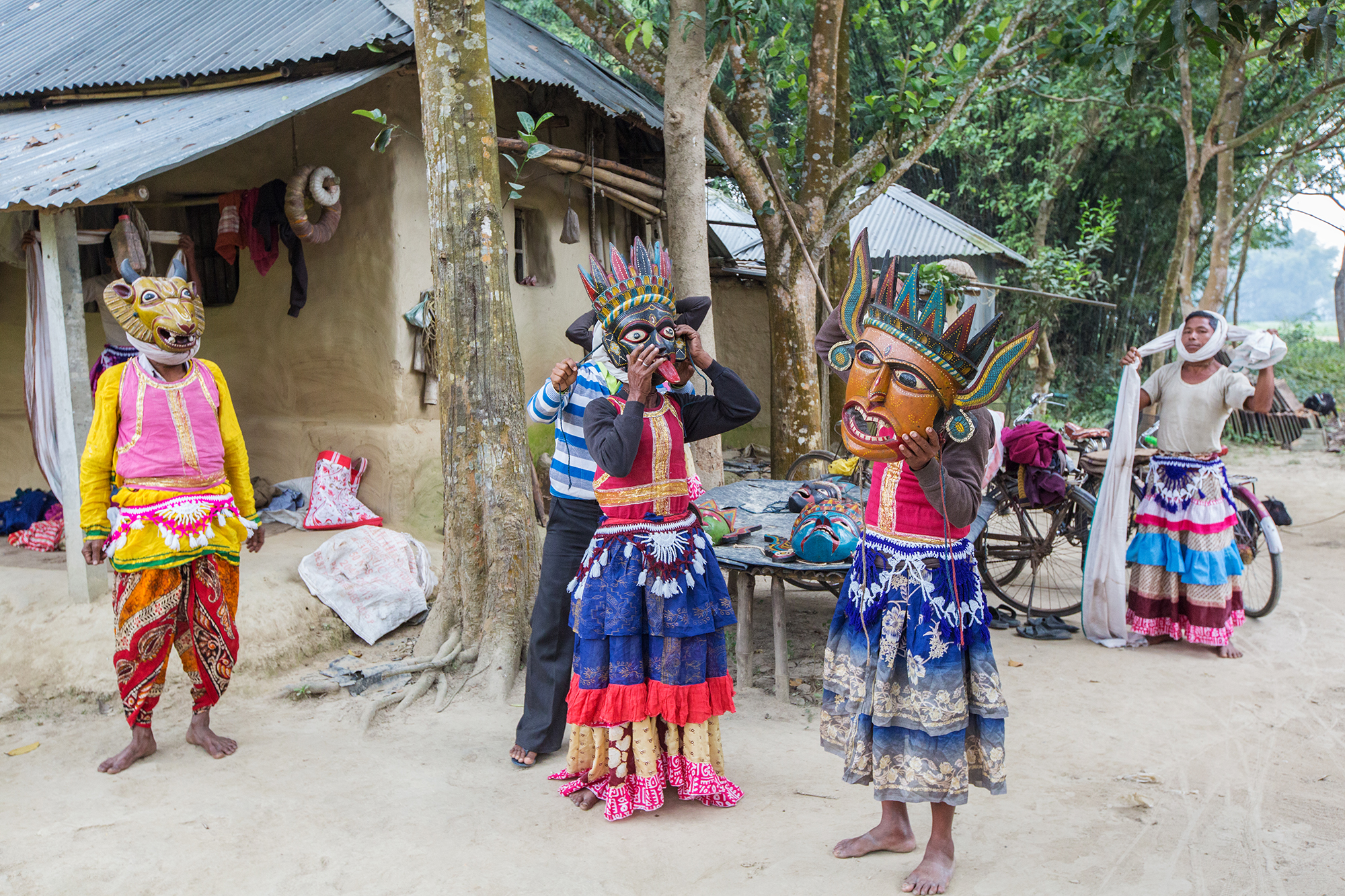The Gomira dance originates in the diffusion of different cultural influences in North Bengal. It is believed to have its origins in Mahayana Buddhism which also has a tradition of ceremonial masked dances. Northern Bengal was under the influence of Buddhism till at least the 12th century, gradually shifting to various Shakti cults, which continue into present times. Gomira was also influenced by the local animist cults followed by different tribal communities of the region.
Kushmandi, a tiny block in the district of North Dinajpur, West Bengal has largely been an unheralded place. Like most rural villages in the state, people are dependent on agriculture and fishing. But what sets this area apart is its long tradition of Gomira Dance. Celebrated with wooden mask this dance performance has been confined to this locality for centuries, the baton of heritage being passed from one generation to the next.
Dancers prepare for a performance in the backyard of a village house, assisting each other in putting on the masks. Masks are heavy and fastened securely with strings behind the dancer’s head.
These masks usually have big hollow mouths which allow the dancers see through them. Alternately, some masks have holes in the eyeballs or narrow slits under the eyes.
The word Gomira is a derived from Gram-Chandi, a female village deity. The Gomira dances are organised to appease the deity to usher in the 'good forces' and drive out the 'evil forces'. It is usually organised during mid-April to mid-July. There are no fixed dates but each village in the block has its own Gomira dance troupe and organises at least one dance performance during this period.
The dancers are all male, and portray one or many characters, male, female or animal. They dance to the accompaniment of Dhak and Kansar but one interesting aspect is that the total absence of any songs or chants. Traditionally, the Gomira dance starts with the entry of two characters Buro-Buri, who are actually the human forms of Shiva and Parvati. After the initial round of dancing, characters are called on to the stage. The last and perhaps the most powerful character is Narsingha-Avatar, symbolically showing the ultimate triumph of good over evil. An interesting feature of these dance performances are the trances or Bhor, as it is known in the local language.
The masks which form the most integral part of the Gomira dance has emerged as a small scale cottage industry in this region. The wood crafted Gomira masks represent the characters of the two distinct forms of dance – the Gomira and the Ram-Vanwas. Most Gomira face masks have subsidiary characters crafted along the periphery of the main character. The craft itself is evolving. and the exposure to the outside world influences the craftsman and is later reflected in their work.
The Gomira dance originates in the diffusion of different cultural influences in North Bengal. It is believed to have its origins in Mahayana Buddhism which also has a tradition of ceremonial masked dances. Northern Bengal was under the influence of Buddhism till at least the 12th century, gradually shifting to various Shakti cults, which continue into present times. Gomira was also influenced by the local animist cults followed by different tribal communities of the region.
Historically the masks were made from 'pure woods' such as neem, but these days cheaper wood such as mango, pakur, kadam, gamhar are used to cut down on the cost. For the ease of use paper mache masks are also being made now a days, which are less durable. Just like the Gomira dancers Gomira mask making is a ‘men-only’ profession. Over the years, their tribal or original family surnames have been lost and most of them use Sarkar as their family name.
Villagers pledge (mannat) a certain type and number of masks to their favoured deity when they put forward a wish to be fulfilled. That is how the tradition of mask making began but with the word of fine art spreading demand has grown far beyond the boundaries of the district and the state and are now finding takers in the home of connoisseurs around the world.


































































